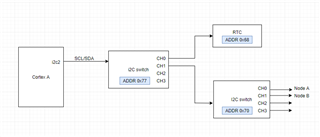Hi,
In our application we have a TCA9546A with addr 0x77 connected to the core i2c2 of Cortex A running Ubuntu. We are able to probe devices connected to Channel 0 of the switch 0x77. On Channel 1 we have another i2c switch with addr 0x70. We are having issues probing the switch with addr 0x70. I was wondering if you have any documentation or support related to device tree implementation for mult-level i2c switches as in our case.

Thanks,
Nikhil


